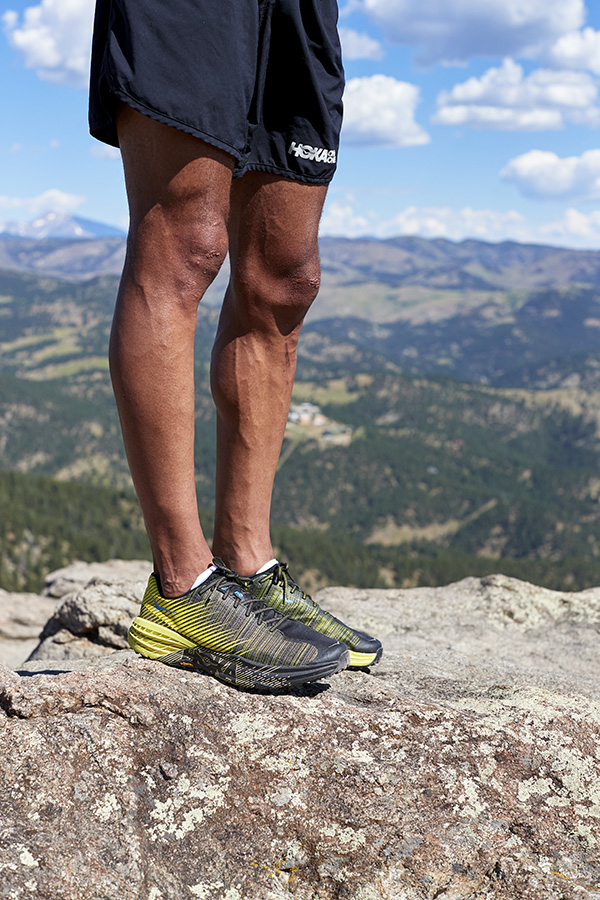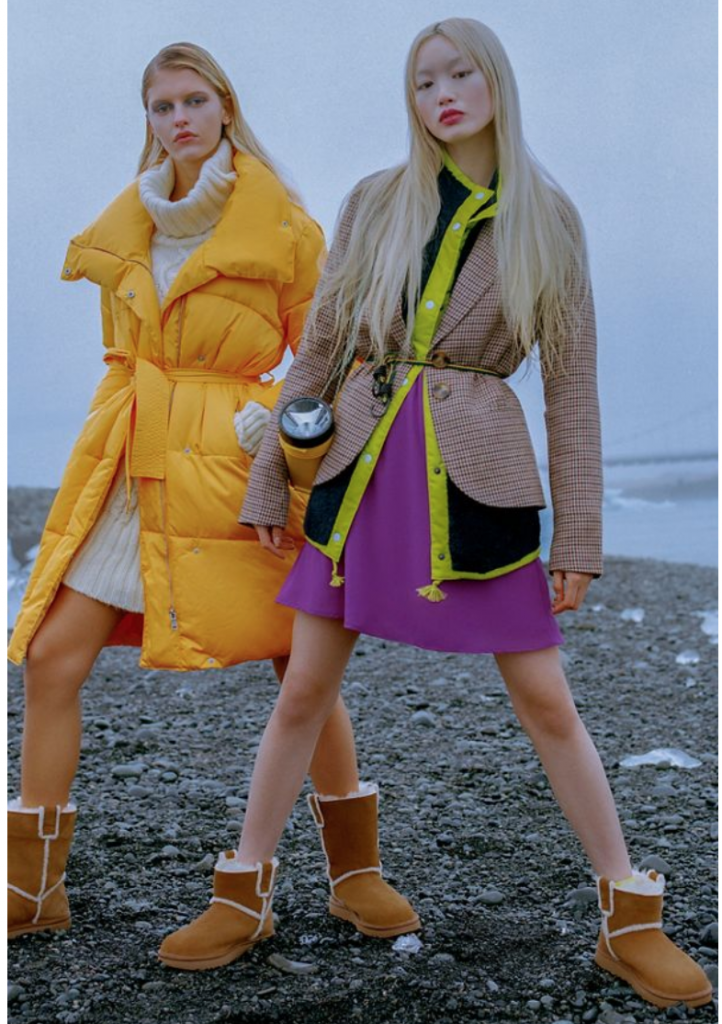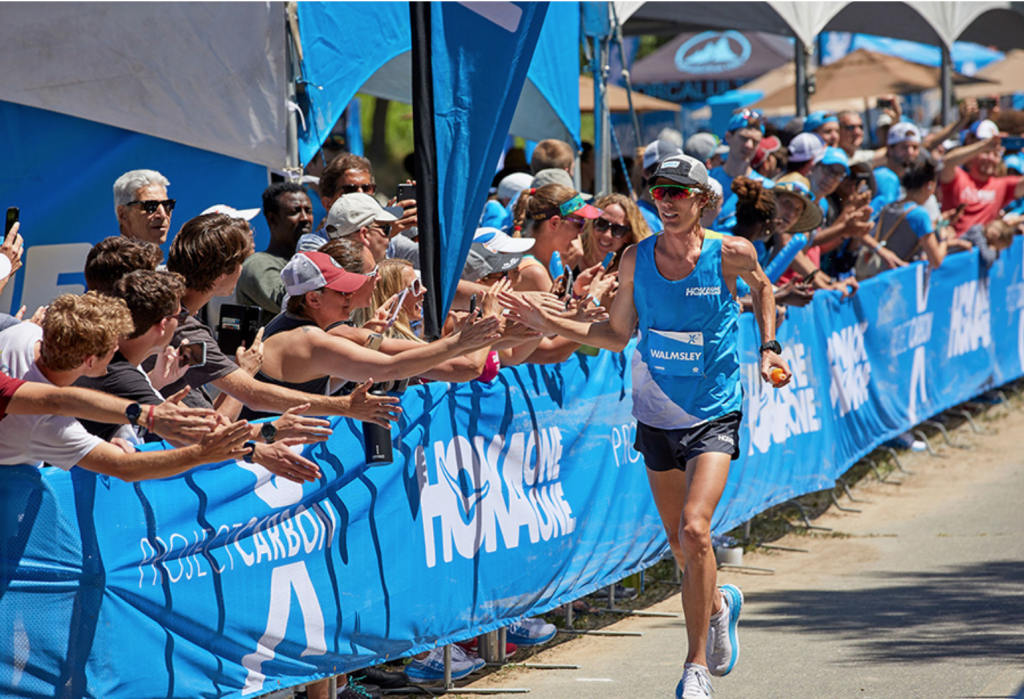By Thomas J. Ryan
<span style="color: #a8a8a8;">Deckers Brands reported the largest revenue and earnings quarter in its history, helped by successful diversification efforts for its flagship Ugg brand and another quarter of explosive growth for Hoka One One. Deckers again raised its outlook for the year.
In the third quarter ended December 31, sales increased 7.4 percent to $938.7 million, exceeding guidance calling for sales in the range of $885 million to $900 million. On a constant-currency basis, sales increased by 8.4 percent.
Net income improved 2.7 percent to $201.6 million, or $7.14 a share, far ahead of guidance calling for earnings in the range of $6.30 to $6.40. Excluding restructuring charges that lowered year-ago results, earnings were up 4.0 percent on a proforma basis.
In mid-day trading on Friday, Deckers’ shares were trading up around $21, or 12 percent, to $198.
 Hoka Claims Number Two Share In Run Specialty
Hoka Claims Number Two Share In Run Specialty
Hoka’s sales for the quarter catapulted 63.6 percent to a record of $93.1 million from $56.9 million for the same period last year.
Hoka experienced growth both domestically and internationally across all channels of distribution.
“The Hoka brand acquired new consumers online through brand discovery while also seeing a migration of consumer replenishment,” said Dave Powers, Deckers’ president and CEO on a conference call with analysts.
In the quarter, Hoka nearly doubled the number of consumers acquired at Hokaoneone.com. Said Powers, “The Hoka brand has made great strides in creating a seamless consumer experience through the entire brand ecosystem which includes the strong network of wholesale partners and direct-to-consumer channels.”
At the same time, efforts to build brand awareness continued with the launch of the “Time To” campaign. The “Time To Reimagine” video garnered significant impressions across social platforms helping to drive more than a 50 percent increase in brand search interest according to Google Trends.
From a product perspective, the brand’s Clifton and Bondi styles continue gaining market share in the U.S.-run specialty channel. According to NPD, Hoka claimed the number two brand ranking based on dollars over the summer and has maintained this position each month since while gaining share at a steady pace.
Powers said that while the market share gains are driven by Hoka’s strong partnership at wholesale, the brand’s direct-to-consumer (DTC) business continues to expand at a rapid pace. For the third consecutive quarter, Hoka’s DTC sales doubled over the prior year. Helping to drive these gains, Hoka doubled the number of DTC purchasers aged 18 to 34. The introductions of the Rincon and Carbon X, as hoped, have over-indexed with younger consumers compared to the brand average.
During the quarter, the introduction of an update to Hoka’s flagship trail shoe, the SpeedGoat 4, propelled the style’s sales to more than double last year’s third quarter. Over half the volume came from international regions. The Tour Ultra, featured as part of the brand’s collaboration with the lifestyle brand Opening Ceremony, has sold well across both domestic DTC and the Asia Pacific wholesale channel.
Internationally, units of Hoka products sold were higher than units sold domestically in the quarter for the first time. Said Powers, “We think this speaks well to the global opportunity and runway for Hoka.”
Teva And Sanuk See Double-Digit Declines
Among other brands in Deckers’ Performance Lifestyle group, Teva’s sales for the quarter decreased 25.1 percent to $17.2 million while Sanuk’s fell 34.5 percent to $8.5 million.
Powers said the performance of both brands were in line with expectations. Teva’s decline was due to a shift in the timing of European distributor orders. Powers said Teva, during the fourth fiscal quarter, would announce a significant brand update to coincide with the launch of a Spring 2020 lines, and the brand overall is on track to meet its revenue targets for the full fiscal year.
Sanuk’s decline reflects continued headwinds from the service specialty channel as well as the brand’s decision to exit distribution at warehouse clubs. Added Powers, “The Sanuk team remains focused on exploring healthier distribution opportunities in an effort to reposition the brand.”
 Ugg Boosted By Momentum In U.S. Wholesale
Ugg Boosted By Momentum In U.S. Wholesale
In the Fashion and Lifestyle group, Ugg’s sales for the quarter increased 2.6 percent to $781.1 million.
The gains were driven by its domestic business as U.S. sales increased 8 percent. The U.S. gains reflected increased traction in the “New Male” franchise as well as extensions across women’s and kids, continued strength in the Fluff franchise and significant gains in kids. Segmentation efforts and inventory discipline are supporting U.S. wholesale strength and enabling Ugg to secure new points of distribution targeting younger and more fashion-forward consumers.
International sales for Ugg declined 7 percent in line with expectation. While some of the weakness in the European market was tied to macroeconomic events, “some brand-specific challenges” exist and a multiyear marketplace reset is taking place in the EMEA region to reignite brand heat. Ugg has also shifted towards more localized marketing, PR and digital marketing tools in the EMEA region as well as in the APAC region.
Regarding the product, Ugg men’s marked its third consecutive year of double-digit growth. Said Powers, “The New Male franchise continues to be a big driver of our men’s success as both heritage products and new derivative styles introduced during the fall season helped deliver strong results. In particular, the New Male Zip and New Male Flex sold through very well in their introductory season.”
Investments in driving awareness are also paying off. Ugg men’s experienced a mid-teens increase in brand consideration among all men and over a 50 percent increase with fashion leading men, according to Hugo. Ugg men’s also saw a near 30 percent increase in 18- to 34-year-old consumers purchasing on Ugg.com.
 Ugg’s women’s business performed well domestically over the holiday season based on accelerated momentum with the younger consumers. Classic Mini, shown right, and Classic Short, as well as newer styles like the Fluff Yeah Slide, resonated with younger women. Similar to men, women’s experienced a near 30 percent increase in purchases with female consumers aged 18-to 34-year- olds in the U.S. on Ugg.com.
Ugg’s women’s business performed well domestically over the holiday season based on accelerated momentum with the younger consumers. Classic Mini, shown right, and Classic Short, as well as newer styles like the Fluff Yeah Slide, resonated with younger women. Similar to men, women’s experienced a near 30 percent increase in purchases with female consumers aged 18-to 34-year- olds in the U.S. on Ugg.com.
Ugg’s kids footwear business grew 20 percent and benefited from strong partnerships with key wholesale accounts and a stronger family positioning for the brand. Takedown styles of the Fluff Yeah Slide and Neumel, shown above, were standouts.
Said Powers, “Diversifying the Ugg brand’s revenue composition remains top of mind, and we’ll continue to focus on amplifying our heritage style while complementing the product offering with exciting new products rich with brand DNA. Overall, the Ugg brand had an exceptional peak season, and I’d like to congratulate the team on a well-executed third quarter.”
Koolaburra, a brand similar to Ugg and sold to mid-tier channels, saw revenues expand 94 percent to $39 million, a few million above guided expectation. Koolaburra gained market share within the domestic wholesale marketplace. Koolaburra men’s and toddlers’ assortments were introduced for the first time this fall and saw strong sell-throughs.
Among channels, wholesale sales for the quarter increased 8.9 percent to $525.1 million. DTC sales grew 5.6 percent to $413.7 million. DTC comp advanced 4.7 percent.
By region, domestic sales increased 12.7 percent to $645.7 million. International sales decreased 2.6 percent to $293.1 million.
Gross Margins Benefits From Reduced Promotions
Gross margins improved to 54.1 percent from 53.8 percent for the same period last year. Margins were approximately 100 basis points above-implied guidance, with the beat coming from lower promotional activity than planned in the Ugg domestic wholesale business as the brand delivered strong sell-in and high full-price sell-through for a third consecutive year. Higher promotional activity was seen in its international markets.
SG&A expenses increased 11.8 percent to $251.9 million and were up 10.6 percent on a non-GAAP basis versus last year, in line with implied guidance. On a non-GAAP basis, SG&A expenses increased to 26.8 percent of sales from 26.1 percent.
Full-Year Outlook Raised
For the full-year, Deckers slightly lifted its revenue guidance and improved its EPS outlook by 45 cents. Of the 45 cents improvement, 25 cents came from a lower promotional environment, 15 cents from Hoka’s outperformance and 5 cents from an improved outlook on margins in the fourth quarter.
The updated outlook for the year ended March 2020 includes:
- Net sales are now expected to be in the range of $2.150 to $2.160 billion, up from $2.115 to $2.140 billion previous;
- Ugg is still expected to be flat to up low single digits. Hoka revenue is now expected to reach approximately $350 million, up 57 percent from $223 million last year. Deckers had projected Hoka’s growth would be up high 30 percent during its second-quarter conference call and saw growth in the mid-20 percent range at the start of its fiscal year. Teva revenue is still expected to be approximately flat. Sanuk revenue is still expected to be down in the mid-30 percent range. Koolaburra revenue is still expected to grow to approximately $70 million;
- Gross margin is now expected to be approximately 51.5 percent, up from guidance of 50.8 percent previously;
- SG&A expenses, as a percentage of sales, are still projected to be slightly lower than 36.0 percent;
- Operating margin is now expected to be at, or slightly better than, 15.5 percent, versus 15.0 percent under the previous guidance; and
- Diluted EPS is now expected to be in the range of $9.40 to $9.50 compared to a range of $8.90 to $9.05 previously.
For the fourth quarter, sales are expected to be in the range of $392 million to $402 million against $394.1 million a year ago. EPS is expected to be in the range of 35 to 45 cents against EPS of 85 cents on an adjusted basis a year ago.
Photo courtesy Hoka One One, UGG
















